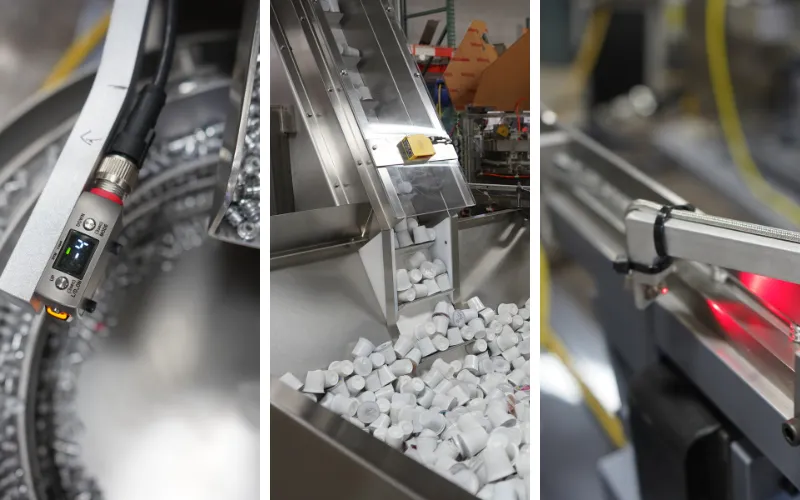In the world of automated parts feeding and conveying, precision isn’t just preferred, it’s essential. Every component must be in the right place, at the right time, in the correct orientation. That’s where sensors step in as the critical intelligence layer, transforming mechanical systems into smart, responsive automation solutions.
At Hoosier Feeder, we’ve seen firsthand how the right sensor integration can mean the difference between a system that moves parts and one that delivers true operational excellence. Here’s how sensors are revolutionizing parts feeding efficiency, accuracy, and safety across manufacturing applications:
Consistent Control: The Foundation of Reliable Feeding
Part Presence Detection That Prevents Downtime
Proximity sensors, vision sensors, and optical cameras serve as the precision checkpoints of your feeding process. Positioned at critical points, such as escapements that release parts one at a time or load points in your feeder system, these sensors detect the presence or absence of parts with split-second precision.
When a part isn’t in the correct position, the system immediately responds, halting the feeder, triggering alternative actions, or alerting operators before problems cascade downstream. This real-time intelligence prevents costly downtime and ensures seamless production flow.
Level Control That Maximizes Uptime
Nothing disrupts production quite like an empty hopper or an overfilled feeder bowl. Optical or part-present sensors continuously monitor part levels within feeders and hoppers, maintaining the crucial balance between too much and too little.
When levels fall below set points, sensors automatically trigger refill sequences or alert operators for manual intervention. Equally important, they prevent overfilling that can lead to jams, component damage, and system failures.
Feed Rate Regulation for Smooth Operations
Sensors work in sync with control systems to regulate part flow and maintain consistent feed rates. This coordination ensures an uninterrupted supply to downstream processes. Resulting in a smoother operation with fewer interruptions and more predictable throughput.
High-level sensors positioned along feeder tracks and conveyors add another layer of protection, preventing jamming and overfilling by detecting excessive accumulation and automatically pausing feeders when necessary.
Orientation and Quality: Precision Where It Matters Most
Smart Part Orientation
Vision sensors and cameras provide the intelligence needed to guarantee the correct part orientation for packaging or picking every time. No matter the feeder system, vibratory, centrifugal, or conveyor, sensors ensure parts are consistently in the specific orientation required for assembly, inspection, and more.
This capability is especially valuable in applications where part geometry creates orientation challenges—scenarios where traditional mechanical methods might struggle to achieve consistent results.
Integrated Quality Control
Quality control becomes seamless when vision systems and sensors inspect parts as they exit feeders or move along conveyors. These systems monitor critical parameters, such as dimensions and other quality attributes, in real-time.
Defective or misoriented parts are automatically rejected and either recirculated or removed from the system entirely. This immediate quality verification improves product quality and enhances traceability, both crucial factors in today’s manufacturing environment.
Safety and Efficiency: Where Intelligence Meets Protection
Collision Prevention and Flow Management
Proximity sensors detect objects in conveyor paths, preventing collisions and maintaining steady product flow. This proactive approach protects both products and equipment while ensuring consistent throughput.
Speed and Load Control
Speed sensors maintain constant conveyor speeds, preventing bottlenecks that are particularly problematic in synchronized processes. Weight sensors monitor product loads, preventing overloading that could damage systems or create safety risks.
Minimizing Human Error
Sensors reduce the likelihood of errors by automating tasks that would otherwise require human oversight. This automation not only improves consistency but also allows operators to focus on higher-value activities.
The Intelligence Layer That Transforms Automation
Sensors truly act as the “eyes and ears” of automated parts feeding and conveying systems. They provide real-time data that enables precise control, immediate problem detection, and proactive responses that maintain efficient, accurate, and safe operations.
At Hoosier Feeder, we integrate sensor technology thoughtfully into every custom solution we design. Whether you’re handling delicate components that require gentle touch sensing or robust parts that require high-speed detection, the right sensor configuration can significantly enhance your system’s performance.
Ready to add intelligence to your parts feeding system?
Our team specializes in integrating sensors seamlessly into custom feeding solutions that meet your exact application requirements. From initial system design through final installation, we ensure your sensor integration delivers the precision, reliability, and efficiency your operation demands.
Contact Hoosier Feeder today to discuss how sensor technology can transform your parts feeding challenges into automated solutions that deliver consistent results, day after day.
